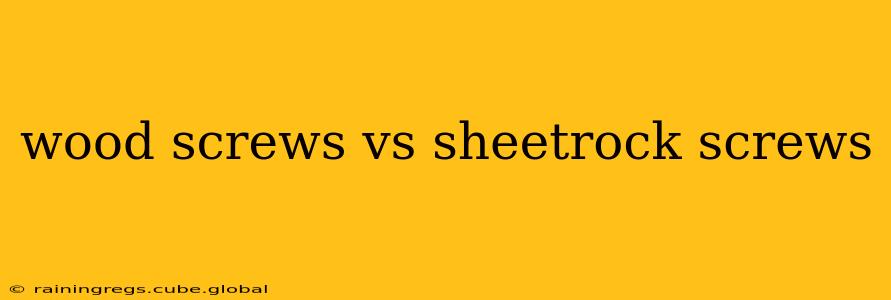Choosing the right screw for your project can significantly impact its success and longevity. While both wood screws and sheetrock screws look similar at first glance, they have distinct differences that make them suitable for different applications. This comprehensive guide will explore the key distinctions between wood screws and sheetrock screws, helping you choose the right fastener for your next project.
What are Wood Screws?
Wood screws are designed for joining pieces of wood together. Their sharp, pointed tips and coarse threads easily penetrate wood, providing a strong, reliable hold. They come in a variety of materials, including steel, brass, and stainless steel, and are available in various lengths and head styles (like flat, pan, oval, and round). The coarse threads allow for a strong grip, especially in softer woods.
What are Sheetrock Screws?
Sheetrock screws, also known as drywall screws, are specifically designed for fastening drywall to wood studs or metal framing. They feature a fine, closely spaced thread and a sharp point for easy penetration of drywall. Their fine threads minimize the risk of splitting the drywall, a common issue with wood screws. They typically have a self-tapping design, meaning they don't require pre-drilling in most cases.
Wood Screws vs. Sheetrock Screws: Key Differences
Here's a table summarizing the main differences between wood screws and sheetrock screws:
| Feature | Wood Screws | Sheetrock Screws |
|---|---|---|
| Thread | Coarse, widely spaced | Fine, closely spaced |
| Point | Sharp | Sharp, often self-tapping |
| Head Type | Variety (flat, pan, oval, round, etc.) | Typically flat or slightly countersunk |
| Material | Steel, brass, stainless steel, etc. | Typically steel, sometimes phosphated |
| Application | Joining wood, general wood applications | Fastening drywall to studs or framing |
| Pre-drilling | Often recommended, especially in hardwoods | Usually not required |
| Durability | High, depends on material and application | Suitable for drywall, less robust for wood |
What are the Different Types of Wood Screws?
There are many types of wood screws, each with its own advantages. They can be categorized by their:
- Head Type: Flat, oval, round, pan head. The choice depends on the aesthetic and functionality required.
- Material: Steel (common), brass (decorative), stainless steel (resistance to corrosion).
- Thread Type: Coarse (for softer woods), fine (for hardwoods to avoid splitting).
- Drive Type: Phillips, Torx, square, and more – impacting the tool required to drive them.
Choosing the right type of wood screw depends entirely on your project's demands.
What are the Different Types of Sheetrock Screws?
While the variation is less than wood screws, sheetrock screws also come in some variations:
- Length: Varying lengths are necessary to account for the thickness of drywall and framing.
- Head Type: Generally flat and countersunk, minimizing the protrusion for smoother finishes.
- Material: Steel is the standard, with various coatings (phosphated) for enhanced corrosion resistance.
Can I Use Sheetrock Screws in Wood?
While you can use sheetrock screws in wood, it's generally not recommended, especially for larger projects or applications requiring significant strength. The fine threads may not grip wood as effectively as wood screws, potentially leading to loosening over time. The heads may also be prone to stripping.
Can I Use Wood Screws in Drywall?
Using wood screws in drywall is also generally not advisable. The coarse threads are likely to split the drywall, ruining the surface finish and compromising the structural integrity. The larger head size will also look unprofessional and may not sit flush with the surface.
Conclusion
Understanding the differences between wood screws and sheetrock screws is crucial for successful DIY projects. Choosing the correct screw ensures a strong, lasting bond, avoids damaging materials, and delivers a professional finish. Remember to always select screws appropriate for the materials and the application's specific needs.
